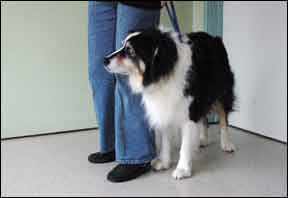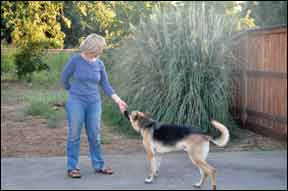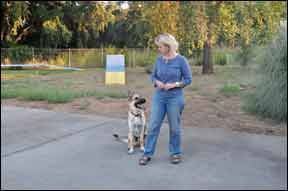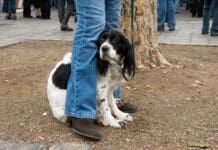FEARFUL DOGS: OVERVIEW
1. Select a menu of strategies from those offered in this article, and start working with your dog.
2. As you try them out, determine which strategies work best for the two of you, and discard the ones that don’t.
3. If you don’t seem to be making progress, seek the help of a qualified, positive behavior professional.
4. If your dog is extremely anxious and fearful, through discussion with your behavior professional and in consultation with a veterinary behaviorist, explore the use of anti-anxiety medications to help improve your dog’s quality of life.
There are a lot of things in our world that have the potential to frighten our dogs. How is it that some dogs deal with these stimuli without batting an eye, while others cower behind their owners with little or no apparent provocation? The Cowardly Lion in the Wizard of Oz seems to say it all in one simple word: “Courage!” But it’s really not so simple. Why do some dogs seem to be consistently brave, while others are timid? Even more important, absent Dorothy and a wizard, how does one go about helping their timid dog get brave?

We’ve written (a lot!) in the past about using counter-conditioning and desensitization to help dogs change their association with fear-causing stimuli in order to change their emotional response. (As just one example of step-by-step instruction for a counter-conditioning program, see “Reducing Your Dog’s Anxieties,” WDJ April 2007.) That’s still good information, and I urge you to review the article to refresh your understanding of that important behavior modification protocol. This article, however, is going to introduce you to several other complementary exercises you can do in addition to counter-conditioning, to help your timid dog learn to cope with a scary world.
Some of the exercises that follow we’ve introduced in other training contexts. Some come in the “change behavior to change emotional response” category by doing fun stuff your dog loves; some have more to do with management; and some do both. If you’ve already taught some of these to your dog it will be easy to apply them in situations where he’s acting fearful. If you haven’t already taught them, there’s no time like the present!
Note: Be vigilant and protect your dog. During the confidence-building period, you must protect your dog from becoming overwhelmed by things that scare him. If, for example, you force your timid dog to accept the attentions of bearded men while he is still fearful of them, or you stay at an event that turns out to be noisy with your noise-phobic dog, he may become sensitized to the scary stimuli, making his behavior worse, instead of better.
Basic Good Manners Training
You don’t have to do a lot of fancy stuff to help your dog become more confident in his world. Simply teaching him basic good manners – to respond appropriately to your cues – will make his environment more predictable. It builds confidence to understand what you’re asking of him, and to understand the consequences of his behavior. Of course it goes without saying that you will use positive reinforcement-based training with him so the consequences are happy ones. Nothing can destroy a timid dog’s confidence faster than the application of verbal or physical punishment; this will convince him he’s right to think the world is a scary and unpredictable place.
Combine his positive reinforcement good manners training with structure in his routine and stability in his life and you will have taken a large step toward increasing his confidence. But of course, you want to do more to help your dog get brave. Happily, you can do that simply by doing fun stuff with him, such as:
Targeting
Targeting means teaching your dog to touch a designated body part to a designated target. (For in-depth information on teaching a dog to target, see “Train Your Dog to Target,” February 2006.) That description doesn’t do it justice; targeting is tons of fun! Many dogs love targeting, partly because it’s easy to do, and partly because it pays off well – “push the button (the target spot), get a treat.”

Since dogs naturally explore the world with their noses and paws, nose and foot targeting are the two easiest. Nose-targeting draws your dog’s eye-contact and attention from a worrisome stimulus to a pleasant one, so that’s the one I find most useful for timid dogs, although foot-targeting can work too.
It’s an embarrassingly simple behavior to teach. Hold out your hand in front of your dog, at nose level or below. When he sniffs it (because he’s curious!), click your clicker (or use a verbal marker, such as a mouth click or a word) and feed him a treat. Remove your hand, then offer it again. Each time he sniffs, click and treat. If he stops sniffing (boring – I’ve already sniffed that!), rub a little tasty treat on your palm, to make your hand smell intriguing, and try again.
You’re looking for that wonderful “light bulb” moment – when he realizes he can make you click and treat by bumping his nose into your hand. His “touch” behavior becomes deliberate, rather than incidental to sniffing your hand. When you see him deliberately bumping his nose into your hand, add the “Touch!” cue as you offer your hand to him. Encourage him with praise and high-value treats. Make it a game, so he thinks it’s the most fun in the world. You want to see his eyes light up when you say “Touch,” and you want him to “bonk” his nose into your hand, hard! Start offering your hand in different places so he has to move to touch it, climb on something to touch it, jump up to touch it.
When he loves the touch game, occasionally ask him to touch twice; tell him he’s a good dog after the first one, and click and treat only the second one. Gradually decrease your rate of reinforcement, until he’ll touch several times before he gets his click and treat. Then click and treat several in a row. Mix it up, so he never knows when the click will happen – but the click and treat always happen eventually!
Now try playing touch when your dog is a little bit nervous about something. Scary man with a beard and sunglasses passing by on the sidewalk? Hold out your hand and say “Touch!” so that your dog takes his eyes – and his brain – away from the scary thing and happily bonks his nose into your hand. Click and treat. He can’t be afraid of the man and happy about touching your hand at the same time. He also can’t look at the target and stare at the scary man at the same time.
Ask him to touch several more times, until the man has passed, and then continue on your walk. If you do this every time he sees a scary man, he’ll decide that men with beards and sunglasses are good because they make the touch game happen! By changing your dog’s behavior – having him do something he loves rather than acting fearful – you can manage a scary encounter, and eventually change his emotional response to and association with something previously scary to him.
Help Raise Confident Dogs With Confidence-Building Games for Dogs
“Find It”
Like targeting, “Find it” is a behavior many dogs learn to love, and another game you can play to change your dog’s behavior in the presence of a fear-causing stimulus, eventually changing his emotional response. This is also another ridiculously easy and delightful game that any dog can play.
Start with your dog in front of you, and a handful of tasty treats behind your back. Say “Find it!” in a cheerful tone of voice and toss one treat a few feet to your left. When your dog gets to the treat, click just before he eats it. When he comes back to you say “Find it!” again and toss a second treat a few feet to your right. Click – and he eats the treat. Do this back and forth, until your dog is easily moving from one “find it” treat to the other. Then toss them farther each time until your dog happily runs back and forth.
Now if a scary skateboarder appears while you’re walking your dog around the block on his leash, play the find it game, keeping the tossed treats close to you. Your dog will take his eyes off the scary thing and switch into happy-treat mode. You’ve changed his emotions by changing his behavior.
Targeting and find it can also work to walk your timid dog past a scary, stationary object, like a manhole cover, or a noisy air-conditioning unit. Play touch and treat as you walk past, or toss find it treats on the ground ahead of you and slightly away from the scary thing, to keep him moving happily forward.
The Emergency Escape Game
An emergency escape game gives you a “run away” strategy when you know an approaching stimulus will be too much for your worried dog. However, because you’ve taught it to your dog as a fun game, he’s not running away in panic; he’s just playing one of his favorite “get brave” games that just happens to move him farther away from the scary thing.
Teach this game to your dog in a safe, comfortable environment when he’s not being afraid of something. As you are walking with him on-leash, say your “Run away!” cue, then turn around and run fast, encouraging your dog to romp with you for a squeaky toy, a ball, a handful of high value treats at the end of the run, or a rousing game of tug – whatever your dog loves most. The key to success with this exercise is convincing your dog that the “run away” cue is the predictor of wonderful fun and games. Again, you’re teaching him a new, fun behavior – “Run away!” – that you can use to change his emotional response in a scary moment.
Playtime
You can use any behavior your dog already loves – a trick, a toy, a game, anything that lights up his face – to convince him that good things happen in the presence of something scary. If he loves to roll over, ask him to do that. If he delights in snagging tossed treats out of the air, do that. High five? Crawl? Do those.

The key to making any of these games work to help your dog be brave is to be sure you keep him far enough away from the scary thing, at first, that his brain is able to click in to “play” mode. You will always be more successful if you start the games when you see low levels of stress, rather than waiting until he’s in full meltdown. (To learn to recognize how dogs show stress, see “Signs That Your Dog Has Stress,” June 2006.)
If he’s too stressed or fearful, he won’t be able to play. If he’ll start to play with you while the scary thing is at a distance, you’ll be able to move closer. If he stops playing and shuts down, you’ve come too close. Depending on your dog and how fearful he is, you may find some of these play-strategies work well enough to walk him past scary stimuli the first time you try, or you may have to work up to it.
“Get Behind”
“Get behind” is more of a management strategy. Timid dogs often try to hide when they’re afraid. If you teach your dog a cue that means “hide behind me,” your “body shield” can help him get through scary moments. To teach this behavior:
1) Have your dog in front of you, with an ample supply of small, high-value treats in your treat pouch, or in a bowl on a nearby table.
2) Say “Get behind!” and lure your dog behind you and into a sit. Click and treat.
3) Repeat several times, until he lures easily into position.
4) Now say the cue and pause, to give him a chance to think about it and respond. If he moves even slightly, click, lure him into position, and treat. A tentative movement is sometimes a question to you – “Is this what you want?” If you answer with a hearty “Click (Yes!!)” and treat, you can move the training forward more quickly.
5) Keep repeating the cue/pause, gradually reducing how much you lure, until he’s moving into position on his own when you give the cue.
Alternatively, you can shape the “get behind” behavior by clicking and treating small movements toward your final goal. (For more information about shaping, see “Fun Dog Training Techniques Using Shaping!,” March 2006.)
You can start applying this strategy in real-life situations early on in the training, even if before your dog fully grasps the concept, simply by luring him into his safe position as the scary thing passes.
“Treat and Retreat”
“Treat and retreat” is a procedure to help timid dogs get brave. Its development is attributed to two well-known trainers: Dr. Ian Dunbar, veterinary behaviorist and founder of the Association of Professional Dog Trainers, of Berkeley, California; and Suzanne Clothier, who trains in St. Johnsville, New York. While Dr. Dunbar claims credit for introducing the concept, Clothier is generally credited with popularizing the procedure under the “Treat and Retreat” appellation.
To use treat and retreat, start with your dog a safe distance from a person who worries him. Have that person toss a piece of low-value kibble over your dog’s head. Your dog will turn and walk away to get the kibble, then turn back to look at the scary person. When he turns back, have the person toss a high-value treat in front of the dog, in the approximate place the dog was originally. (You may want to use some kind of marker to help your tossing-person’s aim.)

When the dog comes forward and eats the high-value treat, have the person toss another low-value treat behind the dog, then another high-value treat in the original spot. As your dog gets more relaxed about coming forward for the high-value treat, have the tosser gradually decrease the distance, so the dog is going closer to the scary person to eat the treat. If you see increased signs of reluctance with the decreased distance, you’ve decreased the distance too quickly. Go as slowly as necessary to keep your dog happy about this game; you want him moving toward the person tossing the treats happily and voluntarily.
CAT, BAT, LAT
In addition to counter-conditioning, there are other well-developed protocols available to help timid dogs gain confidence. We’ve written about the Constructional Aggression Treatment (CAT) at length (“Modifying Aggressive Dog Behavior,” May 2008; and “Constructional Aggression Treatment (CAT) Can Improve Behavior,” December 2009).
CAT, developed by Kellie Snider and Dr. Jesus Rosales Ruiz at the University of North Texas, uses operant conditioning and shaping (dog does deliberate behavior to operate on his environment) to convince a dog that his old behavior, in this case acting fearful, no longer works to make a scary thing go away. In the presence of a scary stimulus, the smallest sign of relaxation or confidence now makes the scary thing go away – until the dog learns that acting confident (and becoming confident as a result) is a better behavior strategy.
BAT is similar to CAT in some ways, but focuses on having your dog move away from the scary stimulus rather than having the scary thing move away from the dog. Developed by Grisha Stewart, CPDT-KA, CTP, of Seattle, Washington, BAT uses desensitization together with a functional reward for calm behavior. You begin at a distance where your dog can see the fear-causing stimulus (scary man with beard) without reacting to it. When your dog offers any form of calm body language you move away from the bearded man as the functional reward.
BAT defines “functional reward,” as “what your dog wants to happen in that moment.” In the case of a fearful dog, what the dog wants is for the scary thing to be farther away. According to Stewart, a good functional reward for a dog’s calm behavior can be to move away from the scary thing. Similar to CAT, if you teach your dog that calm behavior makes scary things get farther away, your dog will learn to be calm, confident, and not fearful in the presence of those things.
A newer version of BAT simply has you keep your dog on a long leash at a sub-threshold distance from the stimulus until he habituates to its presence, then gradually move closer as his behavior and body language tell you he ready to do so.
LAT stands for “Look At That” – a protocol developed by Leslie McDevitt, CPDT-KA, CDBC, author of Control Unleashed, at her training center outside Philadelphia, Pennsylvania. In LAT, the key is to keep your dog below threshold (quiet and calm) while teaching him to look at a scary stimulus, then rewarding him for looking at it. To train LAT, click and reward your dog the second he looks at the bearded man, as long your dog doesn’t react adversely. If your dog is too close to threshold with the scary stimulus at any distance, start with a neutral target and click as soon as he looks at it. When your dog is offering a quick glance toward the target, name it “Look!”
Your dog will quickly start to look at his scary triggers when you give the “Look!” cue, and turn back to you for a reward. If your dog does not turn quickly, he’s probably too close to or over his threshold. Increase the distance between you and the bearded man and try again. Gradually decrease distance as your dog learns to do the “Look!” game with things that are worrisome to him.
Many of the above games and strategies are compatible with each other. CAT and BAT tend to be mutually exclusive because one moves the dog away from the scary thing, while the other moves the scary thing away from the dog. Other than that, the more of the above strategies you apply, the more tools you’ll have at your disposal to help your dog cope with fear-causing stimuli in his world, and the more confident he’ll become.
Coddling and Cuddling
There is an unfortunate myth floating around in some parts of the dog training world that if you give reassurance to a fearful dog you will reinforce his fearful behavior. Therefore you must ignore your dog when he’s trembling at your feet in fear.
Hogwash. Think back in your own life to a time when you were very frightened or upset. Did it help (or would it have helped) you feel better to have someone you trusted come and put his or her arm around your and calmly reassure you that everything was going to be alright? Of course it did. Our dogs are no different.
One writer created a list of ,”6 Things to Remember When You Have a Fearful Dog,” which is a nice illustration of how kindness and patience can take your dog a long way.
At times when emotions run high, we are more concerned with helping our dogs get those emotions back under control than having him respond perfectly to our cues. In fact, when a dog is very afraid, the emotional part of the brain — the amygdala — takes over, and the thinking part of the brain — the cortex — doesn’t work well. The over-threshold dog isn’t even capable of connecting his behavior to reinforcement, which is why we try hard in our behavior modification protocols to keep the dog below threshold — so learning can happen. If he is shaking in fear, your calm voice and slow, gentle petting can be hugely reassuring to him; fast rubbing and an anxious tone, however, are not.







Hi buddy,
I just read your blog. Your idea is awesome. Great work, thanks for sharing your awesome blog.
I was looking for ideas to help my dogs. Your are great help. Gracias!
After reading the content I felt that it was a helpful idea for my dog.